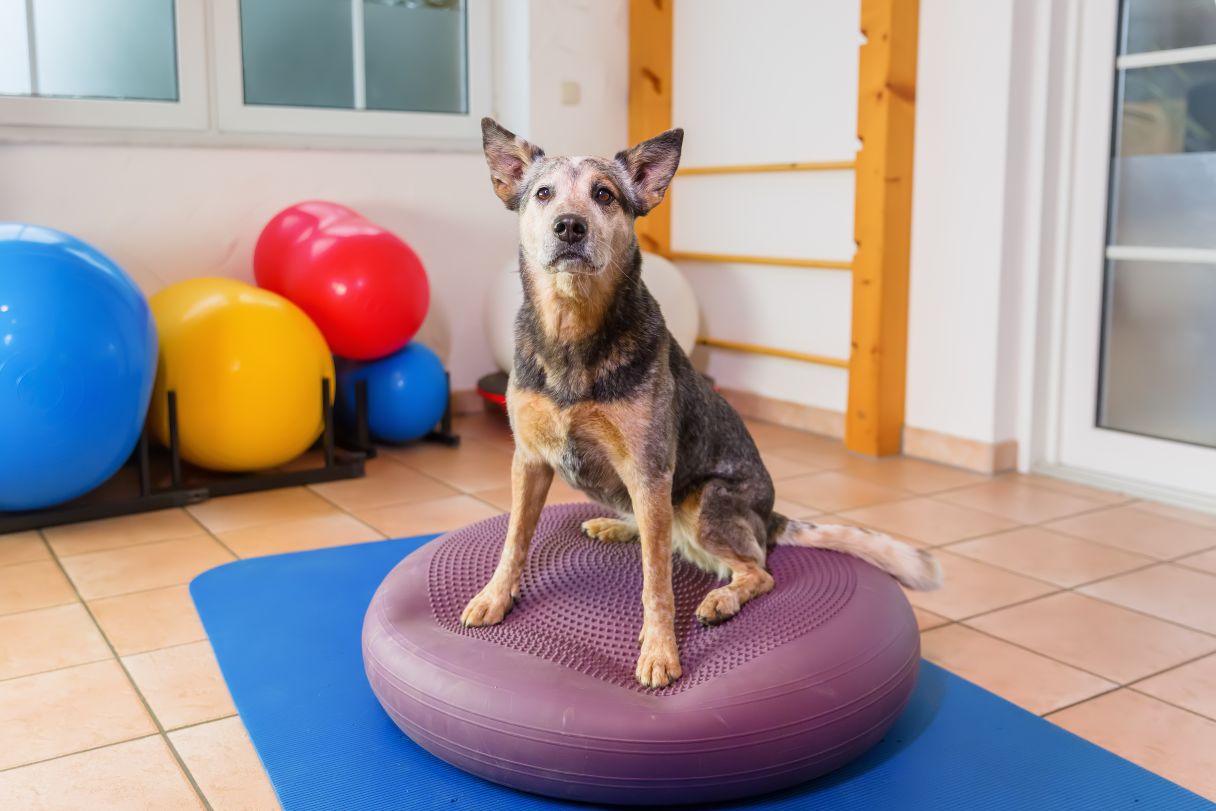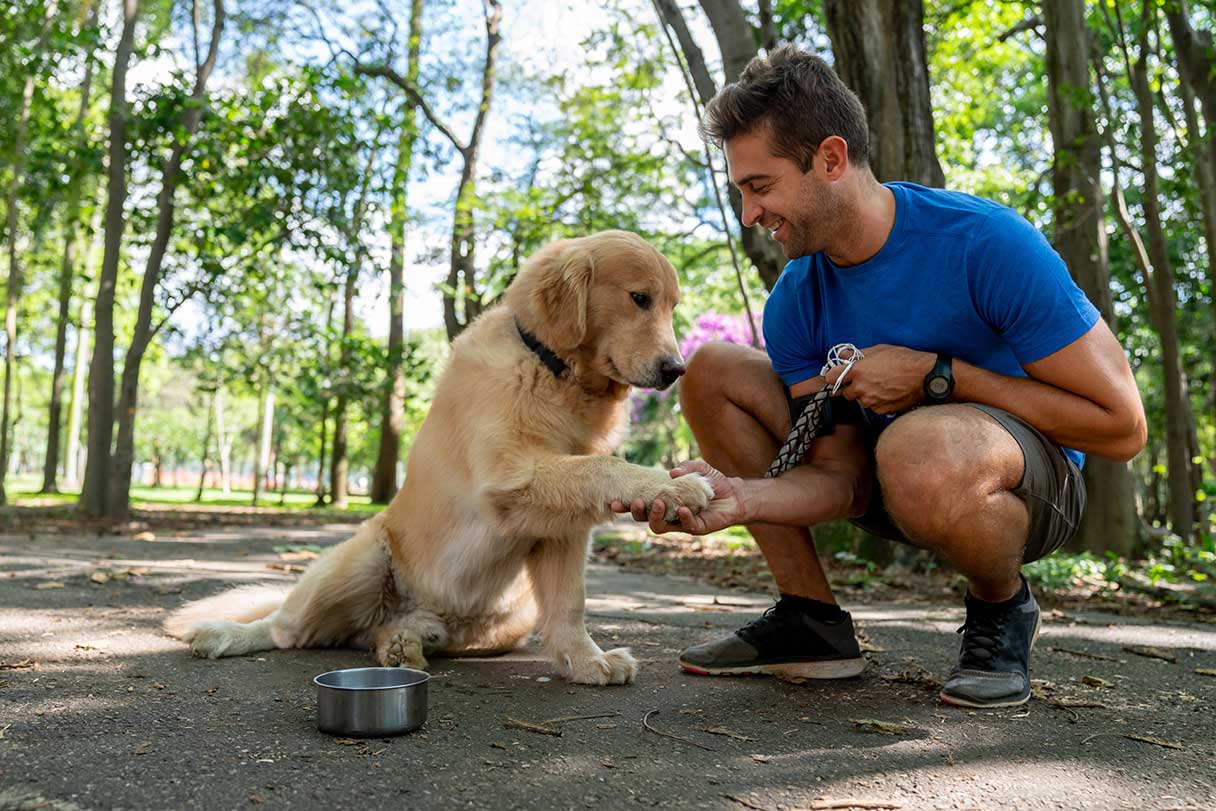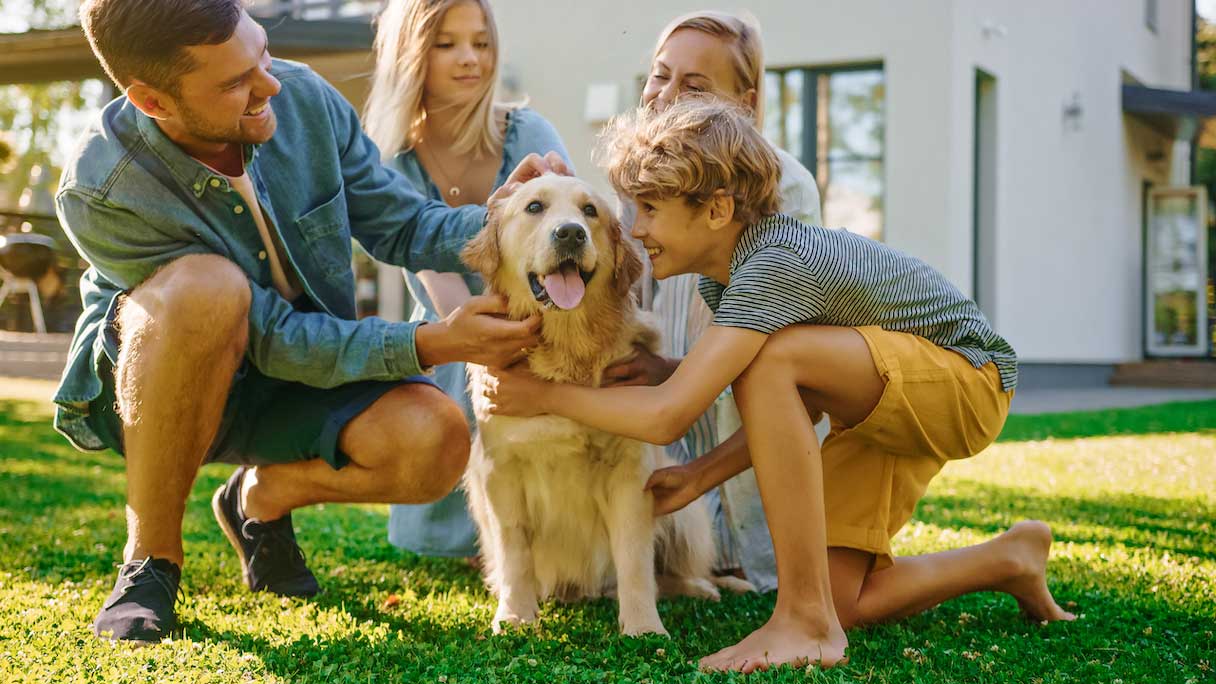Imagine this: You’re playing a game of fetch in the backyard with your dog. They jump to catch the ball, but land with a yelp and fall to the ground. When your dog gets up, they can’t put any weight on their right rear leg.
Your veterinarian diagnoses a cranial cruciate ligament (CCL) tear and performs surgery. When your dog is discharged, the vet informs you that your dog’s recovery plan includes physical therapy. Here's what you can expect.
Overview of Dog Physical Therapy
Canine physical therapy (and/or rehabilitation) is a branch of veterinary medicine that focuses on improving a dog’s physical function, mobility and quality of life after injury, surgery or illness or due to age-related issues. It involves using specific treatments and therapies to manage conditions that are painful or that limit a dog’s physical function.1
Physical therapy is often used to treat conditions involving a dog’s musculoskeletal or neurologic system.1 Goals of therapy include returning the dog to the highest possible level of physical function, preserving their independence and ensuring a good quality of life.2
Canine rehabilitation therapy can be used to help dogs recover from a variety of conditions, including:3
- CCL disease
- Degenerative myelopathy
- Elbow dysplasia
- Fractures
- Hip dysplasia
- Intervertebral disc disease (IVDD)
- Obesity
- Osteoarthritis (OA)
- Osteochondritis dissecans (OCD)
- Patellar luxation
- Sports injuries
- Tendon injuries
- Vestibular disease
In addition, rehabilitation therapy can help keep canine athletes in top performing condition.1
Types of Physical Therapy for Dogs
Canine physical therapy may include one or a combination of several different methods, including:4
- Acupuncture. Veterinary acupuncture is a type of alternative medicine that involves inserting fine needles into specific points on a dog’s body to elicit a physiologic response, such as increased tissue blood flow, decreased pain or muscle relaxation.
- Assistive devices. Devices such as orthotics, braces, prosthetics and carts may be used to support patients while they heal, correct deformities or encourage proper leg use. Carts (or wheelchairs) may be used in the long term to support patients who are partially or completely paralyzed and unable to walk on their own.
- Extracorporeal shockwave therapy (ESWT). ESWT uses high-energy sound waves to stimulate tissue healing.
- Hydrotherapy. Hydrotherapy includes swimming and walking on an underwater treadmill.1 Both therapies take advantage of the water’s buoyancy and resistance to support weak joints, helping dogs regain strength and muscle tone.1 Hydrotherapy can relieve joint pain, improve a dog’s cardiovascular health and speed recovery after surgery.4
- Laser therapy. Laser therapy, or photobiomodulation, uses light energy to stimulate bodily processes, including increased blood flow and muscle relaxation, which help reduce pain and promote tissue repair.
- Therapeutic exercises. A variety of exercises can be used to improve a dog's strength, flexibility, balance and coordination.4 Some exercises may use specialized tools, such as wobble boards, balance blocks and exercise balls.1
- Therapeutic massage. Manually massaging a dog’s muscles can encourage muscle relaxation, increase blood flow, relieve pain and improve mobility.
- Therapeutic ultrasound. Ultrasound uses high-frequency sound waves, which cause microvibrations within tissues that generate heat energy. This increases blood flow, reduces pain, breaks down scar tissue and increases muscle flexibility.
- Thermotherapy. Thermotherapy is the application of cold or heat to tissues for therapeutic purposes. Cold therapy may be used to decrease inflammation and pain, whereas heat therapy can increase blood flow and promote muscle relaxation.
- Transcutaneous electrical nerve stimulation (TENS). TENS uses a low-level electrical current to disrupt pain perception pathways, decreasing inflammation and pain.
- Veterinary spinal manipulative therapy (VSMT). VSMT is similar to chiropractic therapy in people in that it involves techniques to restore and maintain the relationship between the spinal column and the nervous system.
In addition to traditional treatments, such as medication, a combination of rehabilitation therapies may be used as part of a multimodal recovery plan.1 For example, a dog recovering from tibial plateau leveling osteotomy (TPLO) surgery after a CCL tear may be prescribed therapeutic exercises, cold therapy and underwater treadmill therapy as part of their recovery plan.5 Such a plan can often provide better pain control and outcomes than a single treatment type.6
If your dog needs rehabilitation therapy, it is important to search for a veterinarian or veterinary technician who is certified in veterinary rehabilitation.1 They have the necessary training and skills to develop and carry out a rehabilitation treatment plan.2
How Much Does Physical Therapy for Dogs Cost?
The overall cost for a course of physical therapy for your dog will depend on the issue being treated and their overall health status, as these details will dictate the type of therapy and number of sessions required.
In general, you can expect to pay around $180 for an initial consultation, with individual treatment sessions ranging from around $58 to $98.7
The cost of rehabilitation therapies can vary depending on the type of therapy. For instance, chiropractic adjustments typically cost around $65 per session, while medical massage ranges from $47 to $85 per session.7 Acupuncture, commonly used to treat arthritis, has a national average* cost of $150 per session.8
After the initial consultation, your veterinarian will be able to provide a rehabilitation plan, including the number and type of sessions expected, as well as pricing. Keep in mind that every dog heals differently, and the plan may need to be adjusted to accommodate their progress.
How Can You Help Your Dog at Home?
While formal rehabilitation sessions will take place in a veterinary clinic, administered by a certified canine rehabilitation professional, there are many ways you can help your dog at home.
Perform prescribed exercises
Your veterinarian may prescribe exercises for you to perform at home with your dog. If this is the case, your vet can teach you how to do the exercises correctly and provide instructions about how often you should do them with your dog.
It’s important to note that a rehabilitation plan should be prescribed by a veterinarian. You should never try to perform exercises with an injured dog without first being assessed by a veterinarian, who can determine which exercises are safe and appropriate.
Provide mental stimulation
Your veterinarian may recommend exercise restriction during your dog’s recovery, especially during the first few weeks. This may include confining your dog to a crate or small room when you can’t directly supervise them. Dogs with limited activity may become stressed and can benefit from mental stimulation via enrichment activities that are safe for a recovering dog.9
Some enrichment options may include:9
- Collecting items such as sticks, pine cones, grass and leaves that your dog can rummage through and sniff
- Hiding treats in a snuffle mat for your dog to find
- Offering long-lasting chews to help your dog pass the time
- Playing classical music, the radio, audiobooks or the television
- Providing LickiMats® or KONG toys to encourage licking
Feed an appropriate diet
Proper nutrition plays an important role in helping your dog to heal. Your veterinarian may recommend a specialized diet during your dog’s recovery that includes:10
- Healthy fats. Healthy fats, such as omega-3 fatty acids, can decrease inflammation and provide the energy needed for healing.
- Increased protein levels. Protein is essential for tissue repair.
- Vitamins and minerals. Specific nutrients can help your dog repair injured muscle and bone tissue.
If your dog requires activity restriction, they may need fewer calories to prevent weight gain during recovery.10 During the later stages of recovery, however, they may need more calories to provide energy for more intense rehabilitation sessions.10 Your veterinarian can help you determine the appropriate number of calories to feed during each stage of your dog’s recovery.
Administer medications as prescribed
Your veterinarian may prescribe medications to control pain and inflammation during your dog’s recovery.11 It is essential to give all medications as prescribed to ensure your dog remains comfortable and heals properly.
Rehabilitation therapy can be an important part of your dog’s recovery plan after an injury or surgery. Your veterinarian may prescribe multiple therapies as part of a multimodal treatment plan. You can also take specific steps at home to support your dog’s recovery. With a comprehensive plan, your dog can hopefully return to normal activity, including games of fetch, in no time.
CareCredit Credit Card Financing for Dogs
Taking good care of your pet's well-being from nose to tail is essential. Make sure to stay up to date on their regular checkups at the vet to help keep your pet happy and healthy for a lifetime of love. You can use your CareCredit credit card for pet care throughout the year for routine veterinary services as well as emergencies and surgeries.** Use our Acceptance Locator to find a veterinarian near you that accepts CareCredit.
CareCredit is there for you and your pet every step of the way; continue your wellness journey by downloading the CareCredit Mobile App to manage your account, find a provider on the go and easily access the Well U blog for more great articles, podcasts and videos.
In addition to pet care, you can also use your CareCredit credit card for dentistry, cosmetic, vision, hearing, health systems, dermatology, pharmacy purchases, spa treatments and so much more within the CareCredit network. How will you invest in your health and wellness next?
Author Bio
Angela Beal, D.V.M., has more than 20 years of experience as a veterinarian. Leveraging her background in private practice and academia, she uses her passion for writing to convey information to pet owners to help them keep their pets healthy and happy.







